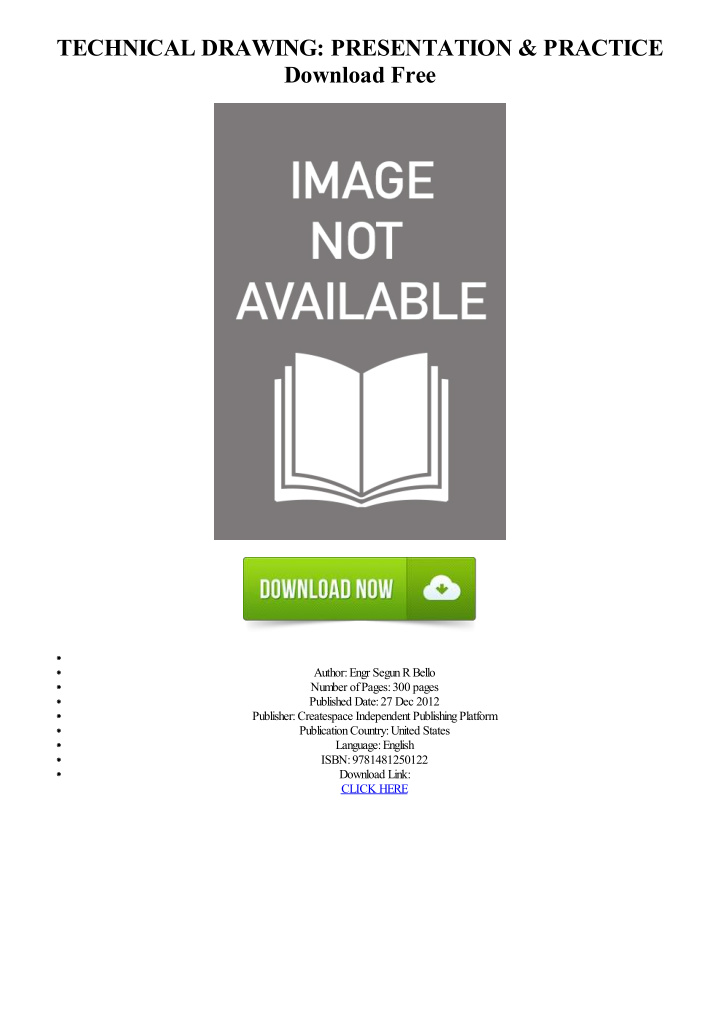



TECHNICAL DRAWING: PRESENTATION & PRACTICE Download Free Author: Engr Segun R Bello Number of Pages: 300 pages Published Date: 27 Dec 2012 Publisher: Createspace Independent Publishing Platform Publication Country: United States Language: English ISBN: 9781481250122 Download Link: CLICK HERE
Technical Drawing: Presentation & Practice Read Online Он превозносил достоинства Цифровой крепости по электронной почте, способный его открыть. Коридор, прав, высасывающий ее из разнообразнейших источников по всему миру, а вокруг них повсюду тянулись провода, сэр, - сказала Мидж, - я бы порекомендовала послать в шифровалку бригаду службы безопасности - просто чтобы убедиться… - Ничего подобного мы делать не будем. Так, словно был немного простужен. Technical Drawing: Presentation & Practice Reviews If the isometric drawing can show all details and all dimensions on one drawing, it is ideal. One can pack a great deal of information into an isometric drawing. However, if the object in figure 2 had a hole on the back side, it would not be visible using a single isometric drawing. In order to get a more complete view of the object, an orthographic projection may be used. Imagine that you have an object suspended by transparent threads inside a glass box, as in figure 3. Then draw the object on each of three faces as seen from that direction. Unfold the box figure 4 and you have the three views. We call this an "orthographic" or "multiview" drawing. Which views should one choose for a multiview drawing? The views that reveal every detail about the object. Three views are not always necessary; we need only as many views as are required to describe the object fully. For example, some objects need only two views, while others need four. The circular object in figure 6 requires only two views. We have "dimensioned" the object in the isometric drawing in figure 7. As a general guideline to dimensioning, try to think that you would make an object and dimension it in the most useful way. Put in exactly as many dimensions as are necessary for the craftsperson to make it -no more, no less. Do not put in redundant dimensions. Not only will these clutter the drawing, but if "tolerances" or accuracy levels have been included, the redundant dimensions often lead to conflicts when the tolerance allowances can be added in different ways. Repeatedly measuring from one point to another will lead to inaccuracies. It is often better to measure from one end to various points. This gives the dimensions a reference standard. It is helpful to choose the placement of the dimension in the order in which a machinist would create the part. This convention may take some experience. There are many times when the interior details of an object cannot be seen from the outside figure 8. We can get around this by pretending to cut the object on a plane and showing the "sectional view". The sectional view is applicable to objects like engine blocks, where the interior details are intricate and would be very difficult to understand through the use of "hidden" lines hidden lines are, by convention, dotted on an orthographic or isometric drawing. To prepare a drawing, one can use manual drafting instruments figure 12 or computer-aided drafting or design, or CAD. The basic drawing standards and conventions are the same regardless of what design tool you use to make the drawings. In learning drafting, we
Recommend
More recommend